



The Ultimate School Deep Cleaning Guide: Transforming Schools Over the Holidays
Deep cleaning a school over the holidays is crucial for maintaining a clean and healthy environment for students and staff. It helps eliminate germs, allergens, and other contaminants that may have accumulated throughout the year. This guide will provide you with a step-by-step approach to deep clean a school, focusing on particularly problematic areas. Additionally, we’ll cover how to deep clean different floor types commonly found in schools.
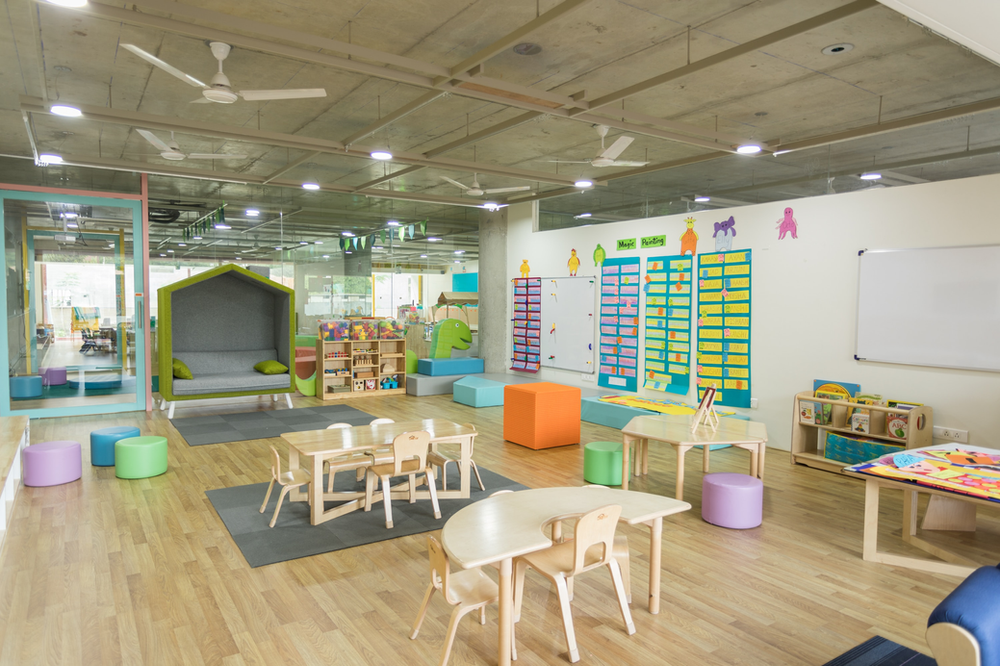
How is a School Deep Clean Different from a Normal Clean?
Deep cleaning a school goes beyond the regular cleaning routines and focuses on thorough cleaning and disinfection of various areas. Here are the key ways in which a school deep clean differs from a normal clean:
Intensity: A school deep clean involves a more intensive and meticulous approach compared to regular cleaning. It aims to eliminate accumulated dirt, germs, and contaminants that may have built up over time.
Comprehensive Coverage:
While regular cleaning typically focuses on surface-level cleaning, a deep clean addresses hard-to-reach areas, hidden corners, and high-touch surfaces that require extra attention. It covers areas often overlooked during routine cleaning, such as baseboards, vents, and light fixtures.
Cleaning Frequency:
Deep cleaning is performed less frequently than regular cleaning. It is typically conducted during school holidays or breaks when students and staff are not present, allowing for thorough cleaning without disruption.
Specialised Equipment and Techniques:
Deep cleaning may involve the use of specialised equipment, such as steam cleaners, floor scrubbers, and carpet extractors, to achieve a more thorough and effective clean. Additionally, specific techniques may be employed to tackle stubborn stains, grease, or other challenging issues that normal cleaning may not address adequately.
Focus on High-Touch Areas:
Deep cleaning places particular emphasis on high-touch surfaces and frequently used areas, such as door handles, handrails, light switches, and classroom supplies. These surfaces are thoroughly cleaned and disinfected to minimise the spread of germs and ensure a healthy environment.
Floor Care:
Deep cleaning includes more extensive floor care, such as carpet extraction, stripping and waxing of hard floors, or using specialised cleaning solutions and machines to remove stubborn stains or buildup.
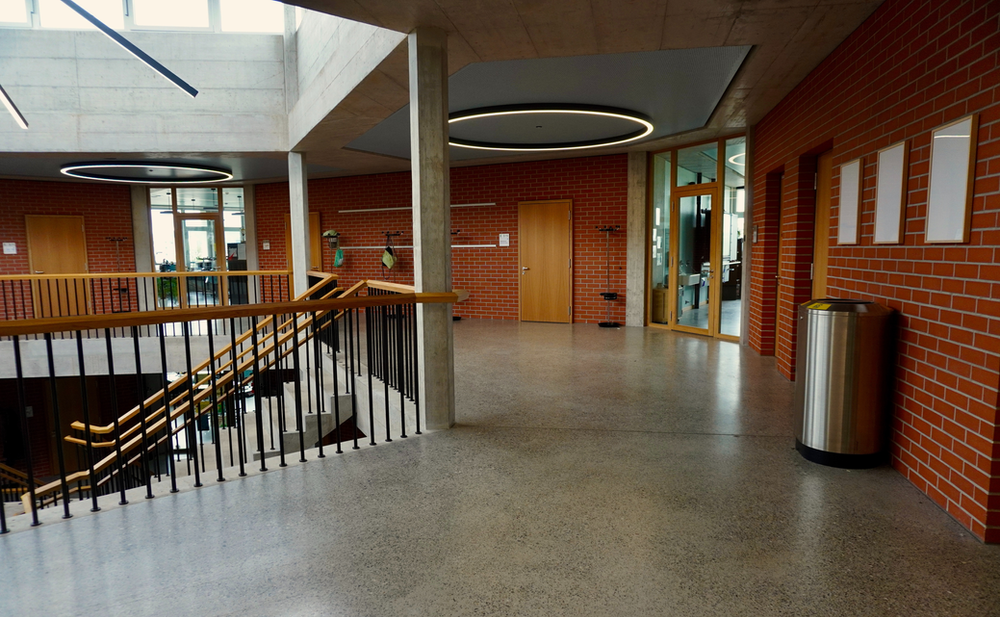
Disinfection Protocols:
Deep cleaning involves a heightened focus on disinfection. Surfaces are not only cleaned but also disinfected using appropriate disinfectants to kill bacteria, viruses, and other harmful microorganisms. Disinfection protocols adhere to industry standards and guidelines for effective sanitisation.
Problematic Areas:
Deep cleaning specifically targets problematic areas in a school, such as restrooms, cafeterias, gyms, Science laboratories, and high-traffic zones. These areas require more thorough cleaning due to the potential for increased dirt, germs, and odors.
By implementing a school deep clean, educational institutions can provide a safe, clean, and healthy environment for students and staff. It ensures that all areas, including those commonly overlooked during regular cleaning, receive the necessary attention to maintain optimal hygiene and well-being.
What are the Benefits of Deep Cleaning a School?
Deep cleaning a school offers numerous benefits that contribute to creating a healthier and more conducive learning environment. Here are the key advantages of implementing regular deep cleaning practices in schools:
Improved Hygiene:
Deep cleaning helps maintain high standards of hygiene by removing dirt, dust, allergens, and germs that can accumulate over time. Thorough cleaning and disinfection of surfaces, equipment, and high-touch areas reduce the risk of infections and the spread of contagious illnesses among students and staff.
Enhanced Indoor Air Quality:
Deep cleaning involves proper dusting, vacuuming, and cleaning of vents, filters, an carpets. This helps to improve indoor air quality by reducing the presence of allergens, pollutants, and particulate matter. Clean air contributes to a healthier environment and can minimise respiratory issues and allergies among students and staff.
Prevention of Illnesses:
Schools can be breeding grounds for germs and bacteria. Deep cleaning, especially the use of effective disinfectants, helps eliminate pathogens and reduces the likelihood of illnesses spreading within the school community. This can lead to a decrease in absenteeism and an overall healthier student and staff population.
Increased Safety:
Deep cleaning addresses potential safety hazards in various areas of the school. By properly cleaning and maintaining floors, stairs, and other surfaces, the risk of slips, trips, and falls can be reduced. Regular cleaning and inspection of equipment, such as playground structures, ensure that they are safe for use.
Positive Learning Environment:
A clean and well-maintained school environment promotes a positive atmosphere for learning. Students are more likely to feel comfortable, motivated, and focused in a tidy and organised setting. Additionally, a visually appealing school environment can enhance students’ pride in their school and encourage responsible behavior.
Prolonged Lifespan of Assets:
Deep cleaning and proper maintenance of school facilities, including floors, furniture, and equipment, can extend their lifespan. Regular cleaning and appropriate care help prevent the accumulation of dirt, stains, and damage, thereby reducing the need for costly repairs or replacements in the long run.
Professional Image:
A clean and well-maintained school creates a positive impression on visitors, including parents, prospective students, and staff. It reflects the school’s commitment to providing a safe and healthy learning environment and can enhance its reputation within the community.
Compliance with Regulations:
Deep cleaning in schools ensures compliance with health and safety regulations, as well as any specific guidelines set by education authorities. By following recommended cleaning practices and protocols, schools can demonstrate their commitment to maintaining a high standard of cleanliness and hygiene.
Staff Morale:
A clean and organised work environment can boost staff morale and productivity. Deep cleaning not only provides a healthier space for teachers and staff but also creates a positive atmosphere that contributes to their overall well-being and job satisfaction.
How often does a school need to be deep cleaned?
The frequency of deep cleaning in a school depends on several factors, including the size of the facility, the number of students and staff, and the specific needs of the school.
Generally, it is recommended that schools undergo a deep clean at least once a year during school holidays or breaks when students and staff are not present. This allows for a thorough cleaning and disinfection of all areas, ensuring a fresh and healthy start to the new academic year.
However, high-traffic areas such as hallways, stairwells, and common areas may require more frequent deep cleaning, such as once every term, to address the accumulation of dirt and maintain cleanliness. Additionally, areas with specific requirements, such as restrooms, cafeterias, and science laboratories, may need to be deep cleaned more frequently, with schedules ranging from daily to monthly, depending on usage and hygiene standards.
Regular assessment of the school’s cleanliness, consultation with cleaning professionals, and adherence to local regulations can help determine the optimal frequency of deep cleaning for each area within the school.
What Equipment Do I Need to Deep Clean a School?
Deep cleaning a school requires the use of specific materials and equipment to ensure a thorough and effective cleaning process. By having the right tools at hand, you can address different surfaces and areas within the school environment. Here are some essential materials you will need for a successful school deep clean:
Cleaning Solutions:
Choose cleaning solutions that are appropriate for different surfaces, such as disinfectants, all-purpose cleaners, glass cleaners, and floor cleaners. Ensure you have a variety of solutions to address specific cleaning needs throughout the school.
Microfiber Cloths:
Microfiber cloths are highly effective for dusting, wiping, and polishing surfaces. They trap and remove dust, dirt, and allergens without leaving behind lint or streaks.
Mops and Buckets:
Select mop heads and buckets suitable for the type of floors you will be cleaning. Consider having both wet and dry mops to address different cleaning requirements. A bucket with a wringer will help efficiently remove excess water from the mop.
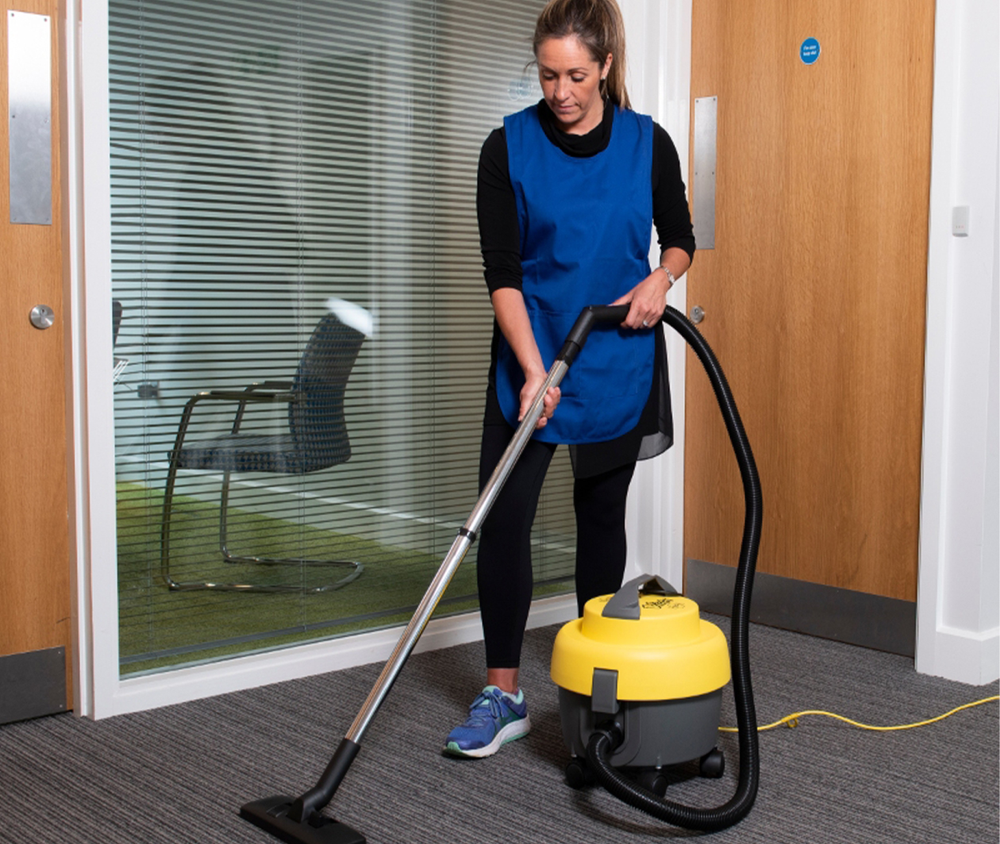
Vacuum Cleaner:
A reliable vacuum cleaner is essential for thorough cleaning of carpets, rugs, and hard-to-reach areas. Ensure your vacuum cleaner has appropriate attachments and filters for different surfaces. A wet and dry vacuum cleaner is useful for addressing spills and wet messes.
Broom and Dustpan:
A sturdy broom and dustpan are necessary for sweeping and collecting debris from hard floors and larger areas. They are particularly useful for prepping the area before mopping or vacuuming.
Rubber Gloves:
Protect your hands from chemicals and potential contaminants by wearing rubber gloves during the cleaning process. This helps ensure your safety and maintain hygiene standards.
Safety Goggles:
For tasks that involve potential splashes or sprays of cleaning solutions, wearing safety goggles is recommended to protect your eyes from any potential hazards.
Disinfectant Wipes:
Disinfectant wipes are convenient for quickly sanitizing small surfaces, high-touch areas, and equipment. Have a supply of wipes that are effective against a broad range of pathogens.
Ladder or Step Stool:
Depending on the height of certain areas, such as reaching high shelves or cleaning windows, a sturdy ladder or step stool may be necessary for safe and thorough cleaning. Ensure the ladder or step stool is stable and suitable for the intended task.
Rubbish Bags:
Keep an ample supply of rubbish bags for collecting and disposing of waste generated during the deep cleaning process. Separate bags for different types of waste, such as general waste and recyclables, can help with proper waste management.
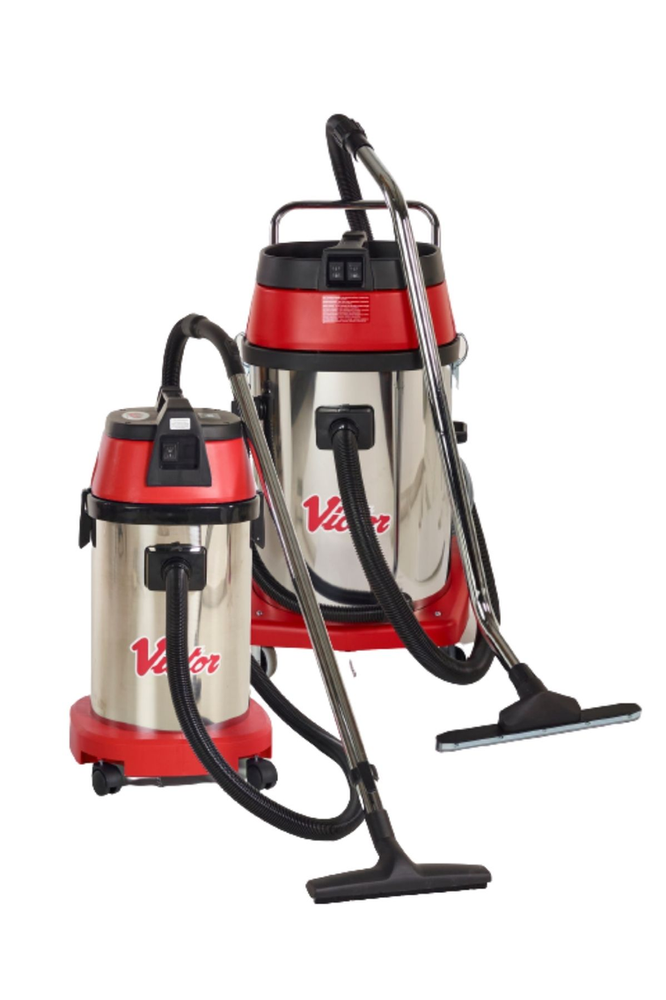
Wet and Dry Vacuum Cleaner:
This versatile machine can handle both dry debris and wet spills, making it suitable for a variety of cleaning tasks.
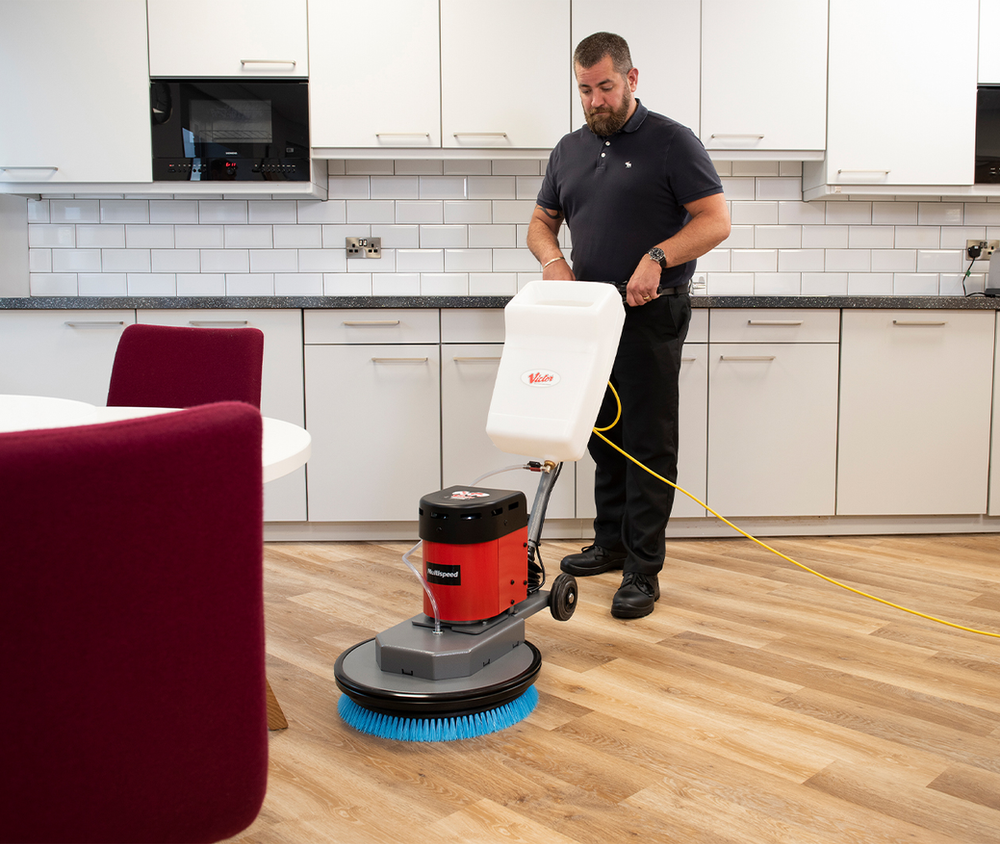
Rotary Floor Machine:
A rotary floor machine equipped with appropriate pads or brushes can be used for deep cleaning and restoring various types of hard floors, such as tiles, vinyl, or hardwood.
If you’d like more more information on rotary machines, be sure to check out some of our other blog posts on Rotary machines:
what is the difference between floor buffers and burnishers?
,How to use a rotary floor polisher / buffing machine
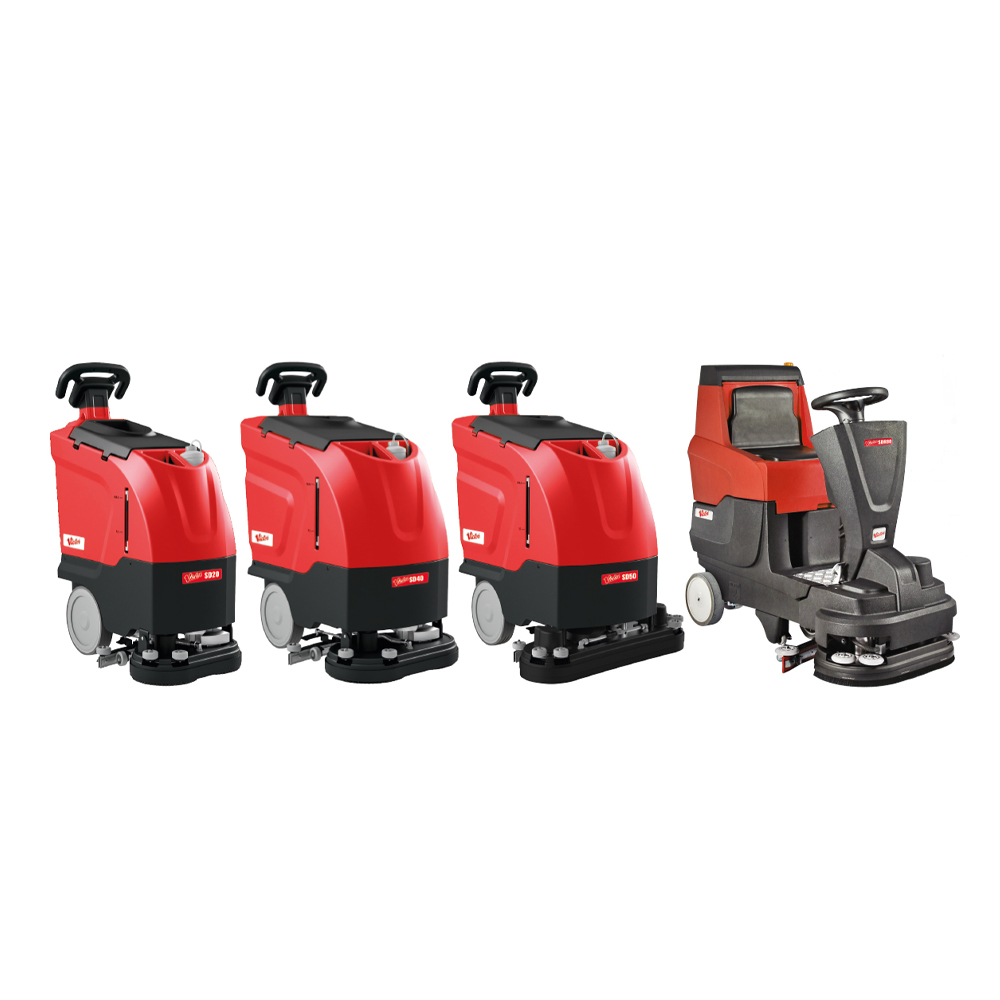
Scrubber Dryer:
For larger floor areas, a scrubber dryer can be used to efficiently clean and dry the floor in a single pass, saving time and effort.
Need some help choosing the right scrubber dryer? Check out our blog – How to choose the right Scrubber Dryer
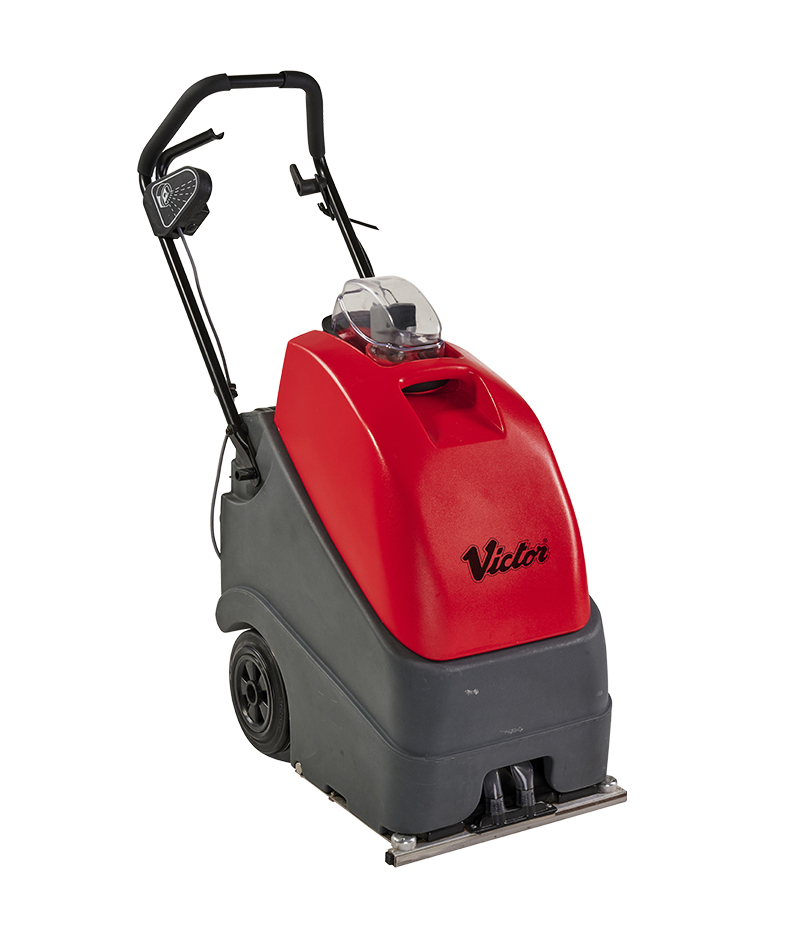
Carpet Cleaning Machine:
A carpet cleaning machine with suitable attachments and cleaning solutions is necessary for deep cleaning carpets and removing embedded dirt and stains.
Having these materials and equipment readily available will help you effectively and efficiently deep clean a school, ensuring a clean and healthy environment for students and staff.
Where do I start with a School Deep Clean?
Preparation is key.
Create a cleaning schedule: Divide the school into sections and create a schedule outlining which areas will be cleaned on specific days.
Ensure you have all the necessary cleaning materials and equipment before starting the deep cleaning process.
How to Deep Clean Different Floor Types in a School
Carpets:
Vacuum the entire area thoroughly, using a vacuum cleaner with a HEPA filter.
Treat stains with appropriate carpet stain removers.
Deep clean carpets using a carpet cleaner such as the Victor SX15 – a walk behind carpet cleaner.
Follow the manufacturer’s instructions for the carpet cleaner and use appropriate cleaning solutions.
Pay extra attention to high-traffic areas and spots prone to stains. For more stubborn stains, consider spot cleaning with a spray extractor such as the Victor CX7
Allow sufficient drying time before allowing foot traffic on the carpets.
Wooden Floors:
Sweep or vacuum the floors to remove loose dirt and dust.
Use a damp mop with a mild cleaning solution specifically designed for hardwood floors.
Avoid excessive moisture, as it can damage the wood. Wring out the mop thoroughly.
Clean in the direction of the wood grain to prevent scratching.
If there are deep scratches or worn areas, consider refinishing the floors after the deep cleaning process.
Once clean, to add a light shine, use a White polishing pad on high speed setting rotary machine or Burnisher such as a Victor Lynx. For spray cleaning, a Red floor pad would be more suitable
If you’d like more information on which floor pad to use on your floor type, check out our blog post: what colour floor pads should you use
Vinyl or Linoleum Floors:
Sweep or vacuum the floors to remove loose dirt and debris.
Mix a mild cleaning solution of warm water and a neutral pH floor cleaner.
Mop the floors, ensuring not to oversaturate them.
Pay attention to stains or scuff marks and use a scrub brush for stubborn areas.
Rinse the floors with clean water to remove any residue.
For regular maintenance, consider regular spray cleaning using a maintainer or neutral pH detergent. Use a Red floor pad on high speed setting or Burnisher such as a Victor Lynx. If sealed, maintain shine with a white floor pad. Periodically scrub with an alkaline detergent on a standard speed machine such as a Victor Contractor.
Tile Floors:
Sweep or vacuum the floors to remove loose dirt and debris.
Mix a solution of warm water and a pH-neutral tile cleaner.
Mop the floors, ensuring to reach grout lines and corners.
For grout lines, use a grout brush and a mild grout cleaner to remove stains and dirt.
Rinse the floors thoroughly with clean water.
If using a rotary machine,consider cleaning with a polypropylene brush. These are ideal at attacking dirt trapped in uneven surfaces or grout lines.
Sports Hall Floors (e.g., Granwood Floors):
Start by removing any loose debris and dust from the floor using a broom or vacuum cleaner with a soft brush attachment.
For regular maintenance, sweep the floor daily to prevent dirt and dust buildup.
Use a mop or floor scrubber with a neutral pH cleaner specifically designed for Granwood floors. Follow the manufacturer’s instructions for the cleaning solution and dilution ratios.
Thoroughly mop the floor, paying attention to high-traffic areas and any visible stains.
For stubborn stains, apply a slightly stronger cleaning solution directly to the affected area and scrub gently with a soft brush.
Rinse the floor with clean water to remove any residue from the cleaning solution.
Allow the floor to dry completely before allowing foot traffic or any sporting activities.
For periodic maintenance, consider applying a suitable floor polish or finish recommended by the manufacturer.
Follow the manufacturer’s instructions for the application of the polish, ensuring an even and thin layer.
Allow the polish to dry completely before using the sports hall.
Regularly monitor the condition of the floor and address any damages or maintenance needs promptly to ensure its longevity.
Remember, deep cleaning sports hall floors is crucial not only for hygiene but also for maintaining the integrity and performance of the playing surface.
The Full School Deep Cleaning Checklist
Classrooms:
- Dust all surfaces, including desks, chairs, bookshelves, and windowsills.
- Wipe down whiteboards or blackboards and remove any stains.
- Vacuum or mop hard floors, paying attention to corners and edges.
- Clean carpets thoroughly using a vacuum cleaner followed by carpet cleaner.
- Disinfect frequently touched surfaces such as doorknobs, light switches, and classroom supplies.
Toilets & Bathrooms:
- Start by putting on rubber gloves and safety goggles for protection.
- Remove rubbish and empty bins.
- Clean toilet bowls, urinals, sinks, and countertops using appropriate cleaning solutions.
- Disinfect high-touch surfaces, such as door handles, taps, and light switches.
- Scrub floors using a mop and a disinfectant cleaner, paying attention to corners and grout lines.
- Consider using a floor scrubber or steam cleaner for a more thorough clean of bathroom floors.
Cafeterias:
- Clear and clean tables, chairs, and benches using a mild detergent or surface cleaner.
- Remove food spills and stains promptly.
- Sweep or vacuum the floor to remove loose debris.
- Mop the floor using a suitable cleaner, paying attention to high-traffic areas.
- Consider using a floor buffer or scrubber for deep cleaning large cafeteria floors.
Kitchens:
- Clean countertops, sinks, and food preparation surfaces with appropriate disinfectant cleaners.
- Pay special attention to grease buildup on stovetops, range hoods, and other cooking equipment.
- Use a degreaser and scrub brushes to remove stubborn grease stains.
- Sweep and mop the floors, using a grease-cutting cleaner for heavily soiled areas.
- Consider using a steam cleaner for deep cleaning kitchen floors and removing grease buildup.
Gymnasiums and Locker Rooms:
- Sweep or vacuum the floor to remove loose dirt and debris.
- Use a neutral pH cleaner and a mop to clean hard floors, paying attention to corners and edges.
- Disinfect sports equipment, mats, and high-touch surfaces.
- Scrub locker room benches, showers, and lockers with appropriate cleaning solutions.
Science Laboratories:
- Follow any specific protocols provided by the school regarding cleaning hazardous substances.
- Clean countertops, sinks, and fume hoods using appropriate disinfectant cleaners.
- Disinfect lab equipment, microscopes, and surfaces regularly.
- Sweep or vacuum the floor to remove loose debris.
- Mop the floor with a suitable cleaner, paying attention to spills and stains.
Libraries:
- Dust and wipe down bookshelves, tables, and chairs.
- Use a suitable cleaner for removing fingerprints and smudges from windows and glass surfaces.
- Vacuum or sweep the floor, paying attention to corners and underneath furniture.
- Consider using a carpet cleaner or steam cleaner for deep cleaning library carpets.
Hallways and Stairwells:
- Sweep or vacuum the floors to remove loose dirt, dust, and debris.
- Use a suitable cleaner for mopping hard floors, paying attention to high-traffic areas.
- Spot clean walls, paying attention to scuff marks and stains.
- Dust handrails, light fixtures, and other high-touch areas.
Classroom Desks and Surfaces:
- Dust all surfaces, including desks, chairs, and bookshelves.
- Wipe down whiteboards or blackboards and remove any stains.
- Vacuum or mop hard floors, paying attention to corners and edges.
- Clean carpets thoroughly using a vacuum cleaner or a carpet cleaner.
- Disinfect frequently touched areas.
Deep cleaning a school over the holidays is essential for maintaining a clean and hygienic environment. By following this guide and focusing on particularly problematic areas, you can ensure that the school is thoroughly cleaned and ready for students and staff to return. Remember to use appropriate cleaning solutions and techniques for different floor types to achieve the best results.
If you have any problem areas in your school, get in contact and our team of friendly, knowledgeable staff will be delighted to assist.
Call us: +44(0)121 706 5771
Email: [email protected]